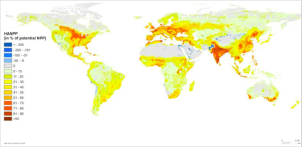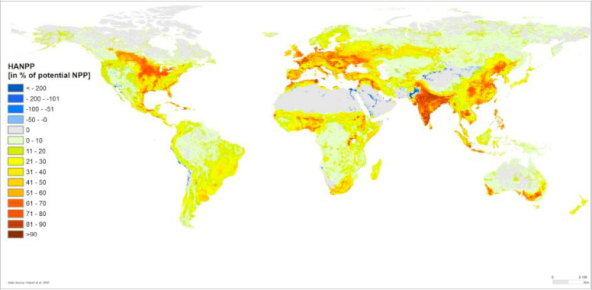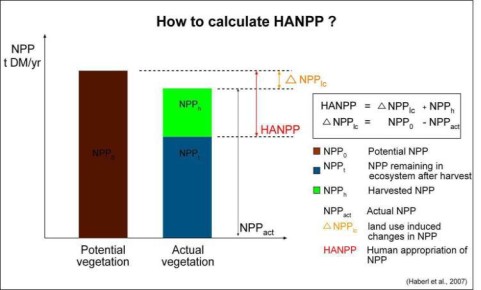
By Nick Meynen.
How do we measure the scale of human activities compared to natural processes? As we evolved from a world almost empty of humans to a full world, that question increasingly occupied the minds of philosophers … and biophysical scientists. The latter came up with an indicator that expresses the physical size of the economy relative to the ecosystem: HANPP or Human Appropriation of Net Primary Production. Basically, it measures how we as humans alter the availability of biomass energy in ecosystems, or what we take before others in the ecosystem can use it. In that way, HANPP is also an indicator of the pressure on biodiversity, as a high HANPP means less biomass energy (and thus food) for all other species in the ecosystem.
Recently, a team of scientists discovered that the share of Net Primary Production appropriated by humans (HANPP) through agriculture and forestry, bio-energy production, and vegetation fires doubled over the course of the past century. While global population increased fourfold over the past century, and economic output increased 17-fold, HANPP “only” doubled. “This shows us that land use became more and more efficient across the globe: The production of food and other products has increased at a much faster rate than HANPP. Nevertheless, HANPP has climbed from 13 to 25 per cent during the past century”, lead author Fridolin Krausman explained.
One added value of HANPP is that it makes a measurable link between natural and socioeconomic processes, which is exactly what ecological economics is all about: making sure that any economic analysis is based on the biophysical reality, rather than a macroeconomic model that neglects these boundaries. In the study published in the Proceedings of the National Academy of Sciences, the researchers (including EJOLT collaborator Christoph Plutzar) from the Institute of Social Ecology at the Alpen-Adria University also warn that an expansion of bio-energy use would drastically raise HANPP to over 40%. All that becomes troubling if one digs a little deeper in the study and starts to reflect on the most likely scenario for the century that starts now.
One of the reasons that HANPP ‘only’ doubled in the past century is that on a global scale, bio-energy has increasingly been replaced by fossil energy. But as we all know and explained in our most recent EJOLT report, this fossil energy is what we should be keeping under the ground as much as possible in the coming century. But regardless of our success in slowing the rate of its consumption, it will be used at a much higher rate than it is made and fossil energy reserves will eventually start to run out. Which means that many people in a much fuller world than a century ago will want to switch back to biomass energy. However, the competition in a much fuller world for that biomass energy will be much higher with a HANPP at 25% or even 40% compared to a HANPP of 13%. Especially when actual regional differences are taken into account. For that reason, the series of global maps on HANPP produced by the team of researchers is an interesting tool to look at both the present and the future: where is the stress on biomass energy already high and what are the HANPP hotspots of the future? That puts conflicts for scarce resources in a different context.
Up to now there is a global high resolution map of HANPP for the year 2000, which EJOLT will integrate in its global mapping of environmental conflicts. For those interested in the HANPP indicator, we already have some useful resources. In this glossary entry, the HANPP concept is explained in more detail. In EJOLT report 5, Issues in the economics of ecosystems and biodiversity, HANPP is used within the context of international trade. Ethanol exports from Brazil, for example, have an embedded HANPP. Which means that the importing countries consume the biomass energy from the exporting countries. In that way, one can make biophysical trade balances and track the highest ecologically unequal exchanges – as we explained in this podcast with Alf Hornborg. At present, the Institute of Social Ecology is producing a report for EJOLT on the HANPP and the global maps it made.
More info: the full article in the Proceedings of the National Academy of Sciences (PNAS)




